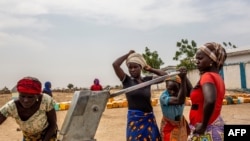After her husband and two children were killed in crossfire between rebels and government forces in March 2015, Mairama Abba, 35, fled to Cameroon to escape deadly upheavals in the Central African Republic.
Abba said her early days in Cameroon were among the most difficult in her life, as she and her children would go without food and water for days. After struggling to survive for two years, however, she received aid from the U.N. children's fund, which saved her children from dying of malnutrition.
She and her two remaining children now live in peace at the Ngam refugee camp in northern Cameroon, she said. Abba said she has no desire to return to her war-torn hometown of Nyem, resolved to care for her children with the money she makes from selling chickens and lambs.
The U.N. and humanitarian agencies say Abba is one of at least 350 women and girls in the Ngam refugee settlement who have since been trained to be self-reliant.
Ohandja Claire Lydie, an official with the International Medical Corps, said in addition to healthcare services, her organization provides training that help refugee women and girls to become less dependent on aid.
Several hundred refugee women and girls now know embroidery, how to make soap, sew dresses and raise animals at home, allowing them to be self-sufficient and mentally prepared to save money and improve their living conditions once they begin working, Lydie said.
As refugees in Cameroon work to integrate themselves into their new communities, locals complain that refugees steal food and cattle, provoke conflicts over water resources, lodging and farmlands and cut down trees for firewood.
Helen Ngoh, a communication associate of UNHCR Cameroon, says on this year's World Refugee Day, UNHCR attempted to persuade host communities to sympathize with the refugees.
"[The] greater majority of Central African refugees, about 330,000 Central African refugees, are still here and they have safety here in Cameroon. If you are forced to flee your home, you should be able to find safety. So this year's [World Refugee Day] theme is drawing attention to the importance of people who are forced to flee their homes to be able to have safety," said Ngoh.
Speaking on Cameroon state broadcaster CRTV, refugees from both the CAR and Nigeria said they are scared to return home because of violence in their native countries.
Meanwhile, UNHCR says less than 15% of the $154 million needed this year to help displaced Nigerians and Central Africans has been raised.







